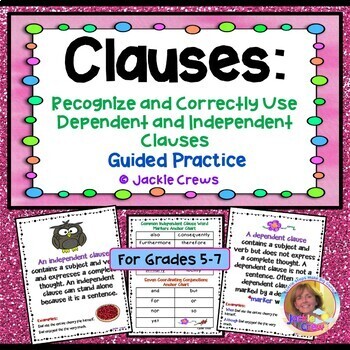CLAUSES Correctly Use Dependent & Independent Clauses w/EASEL DIGITAL PAGES
- PDF
- Easel Activity
Description
If you are looking for a back to school resource that will help you teach students writing confidence and well-structured sentences this one will help. This printable and digital resource will build student confidence in writing. It will help explain what makes dependent and an independent clauses and allow students to practice their learning. It gets to the "meat" of teaching grammar and sentence structure. It fosters variety in student writing and gives and understanding of how sentences are constructed. This is a wonderful resource for back to school and to keep handy all year long.
Please note this resource is leveled for upper elementary and early middle school. Due to the complexity of clauses in general, this is not a resource meant for newcomers, but rather is helpful for students who are progressing. Newcomers and emerging skill levels still need to learn what a basic sentence looks like so please purchase appropriately for your students. There are now eight NO PREP digital pages on Easel you can assign to student devices to follow up learning.
If you purchase open the green view files tab to get access to both the PDF and digital Easel pages. You can choose the pages for your student's devices. Simply go to edit pages and remove the ones you wish to remove for any given assignment. If you wish to change your selections you can revert back to the original pages and choose again. I like this option a lot!
In this resource:
* two teaching posters; dependent clauses and independent clauses (pictured on my title page).
* common dependent clause word marker anchor chart
* an independent clause word marker anchor chart,
* a coordinating conjunction anchor chart
* a student clause fact cheat sheet
* practice pages include two dependent word marker identification sheets, an identification sheet for introductory clauses, a sentence practice sheet with coordinating conjunctions, a practice sheet for independent clauses connected with correct punctuation
* a quiz to identify all of the above clauses, word-markers, and conjunctions
* a creative writing page to use what has been learned.
* core standards page and an ESL Insight feature
* ANSWER KEYs are INCLUDED.
* NEW: 8 NO PREP pages of digital practice by using the TPT digital tool
This resource is useful to ready fifth graders for middle school. It is also useful to teach sentence structures with gifted and talented elementary students grades 4-5. It can be used in grades 6-7 to review sentence structures.
I created this because there were few items available on this topic for my fifth grade English learners . I wanted to break it down to make it easy to learn even with no previous exposure to the topic.
I would use this in increments rather than the whole packet at once, however, it's a teacher's discretion to use it in the best way for their own students. It's adaptable to differentiation.
The standards that inspired me to create this resource:
CCSS.ELA-LITERACY.L.4.1.F
Produce complete sentences, recognizing and correcting inappropriate fragments and run-ons.*
CCSS.ELA-LITERACY.L.5.2.B
Use a comma to separate an introductory element from the rest of the sentence.
CCSS.ELA-LITERACY.L.5.2.C
Use a comma to set off the words yes and no (e.g., Yes, thank you), to set off a tag question from the rest of the sentence (e.g., It's true, isn't it?), and to indicate direct address (e.g., Is that you, Steve?).
CCSS.ELA-LITERACY.L.6.3.A Vary sentence patterns for meaning, reader/listener interest, and style.*
CCSS.ELA-LITERACY.L.7.1.A
Explain the function of phrases and clauses in general and their function in specific sentences.
CCSS.ELA-LITERACY.L.7.1.B
Choose among simple, compound, complex, and compound-complex sentences to signal differing relationships among ideas.
CCSS.ELA-LITERACY.L.7.1.C
Place phrases and clauses within a sentence, recognizing and correcting misplaced and dangling modifiers.
You might also like:
Sentences vs. Fragments DIGITAL PRINTABLE Homework Grab & Go
Compound Sentence Structure: Combining Sentences Task Cards
Fragments, Run-Ons, or Sentences: Sort, Task Cards, & Posters
Creating Compound Sentences Hands on Center
SOCIAL MEDIA:






